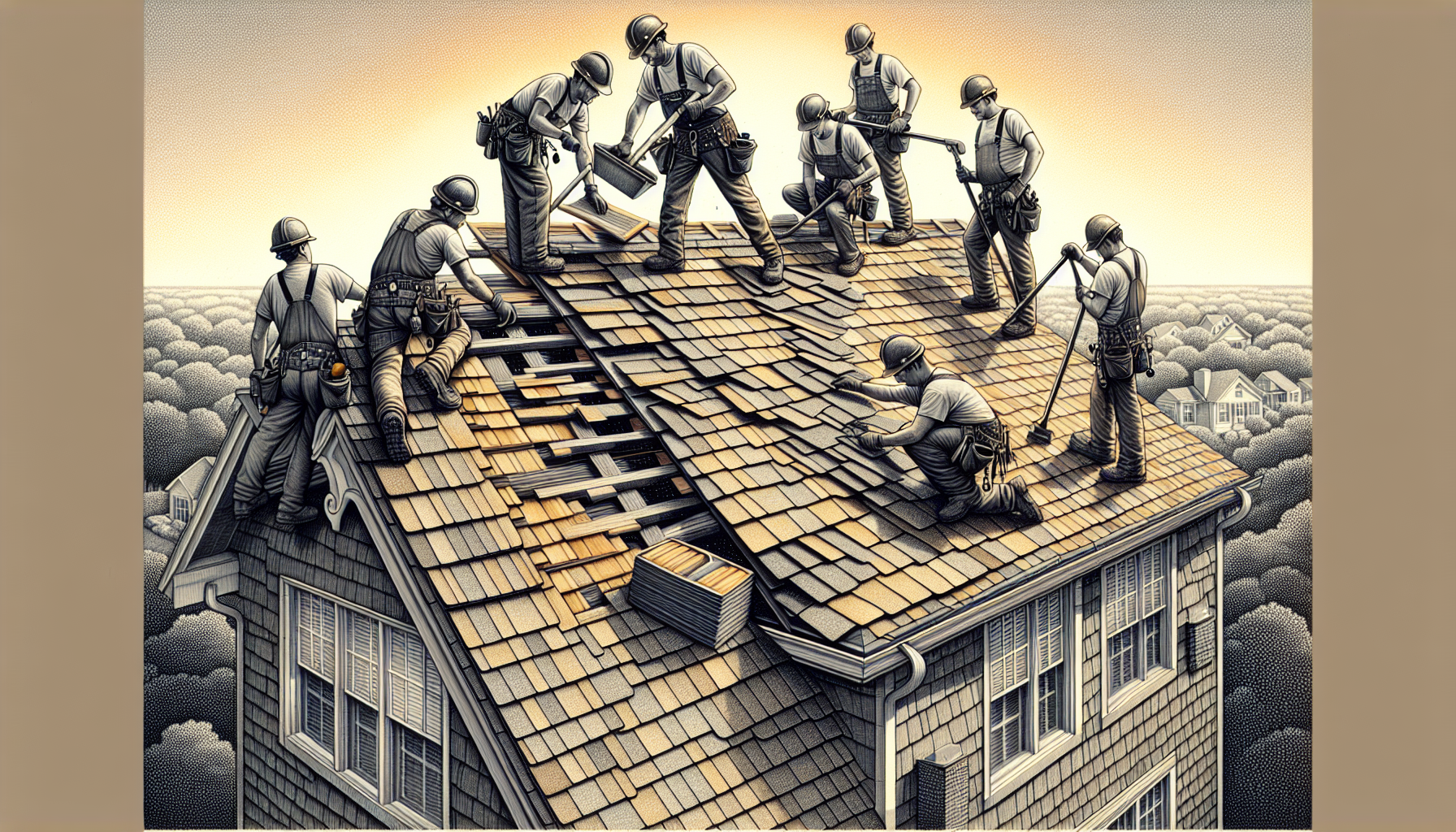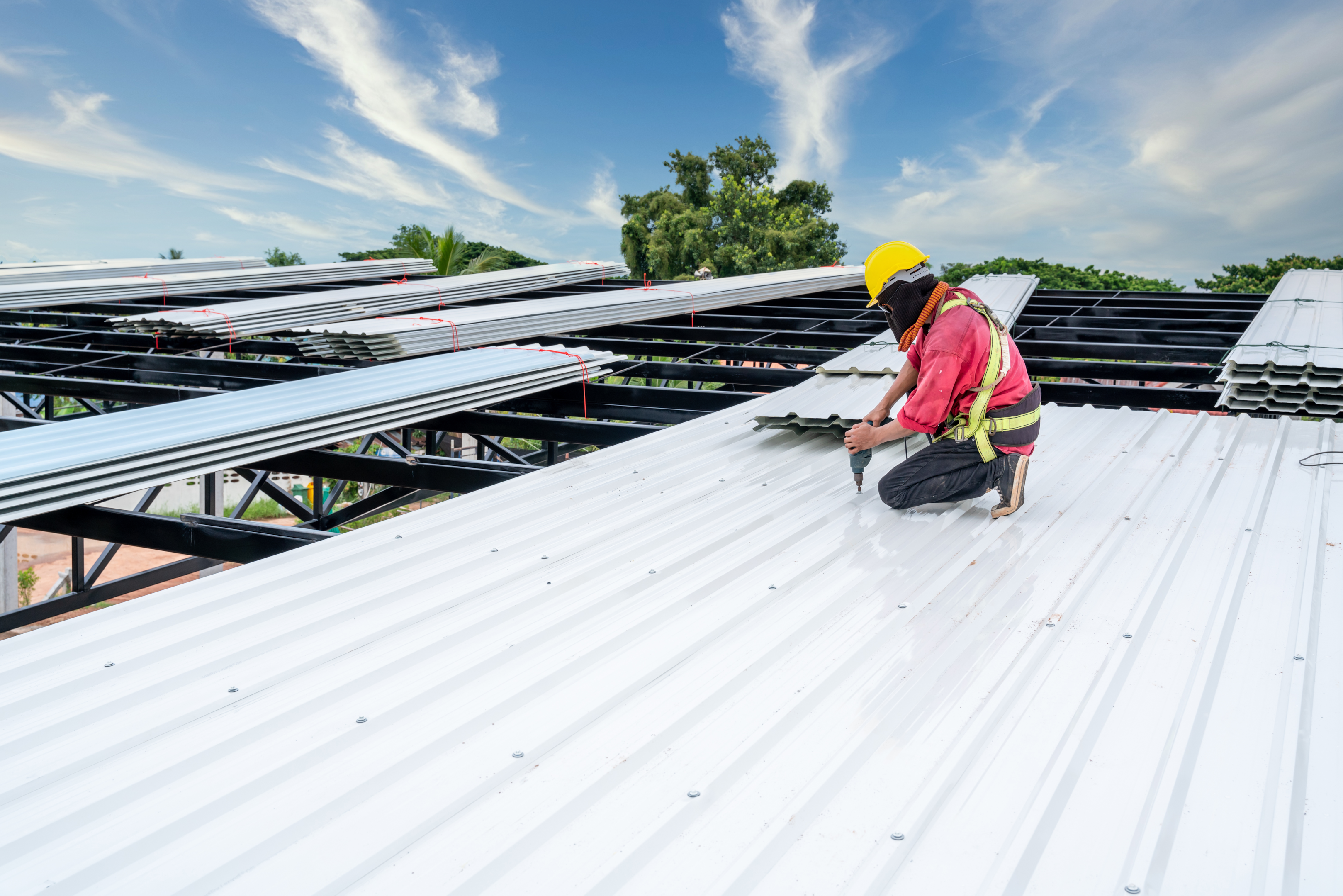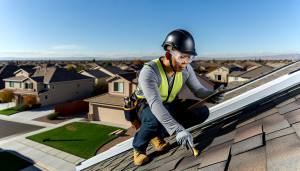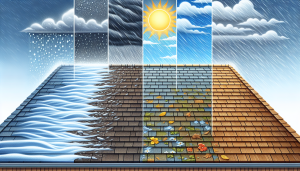A damaged roof needs prompt action, and getting your insurance to cover the replacement is crucial. But how? This no-nonsense guide demystifies the essentials of “how to get insurance to pay for roof replacement”, without the fluff. Understand your coverage, document the damage like a pro, and navigate the claims process with confidence. Start turning policy into payment and patch up your insurance woes along with your roof.
Table of Contents
ToggleKey Takeaways
-
Homeowners need to understand their roof insurance coverage, including whether they have repair or replacement coverage and how the actual cash value (ACV) of their roof may affect claims, to minimize out-of-pocket costs and facilitate claim approvals.
-
Documenting roof damage thoroughly—including taking photos and videos, making temporary repairs to prevent further damage, and filing claims in a timely manner within the insurance company’s specified timeframe—is essential for a credible claim.
-
It’s crucial to work with a reputable roofing contractor who can assist with the insurance claim process, provide a professional roof inspection, and offer proof of their licensing and insurance to ensure quality work and code compliance throughout the roof replacement process.
Understanding Your Roof Insurance Coverage
The first step to a successful homeowners insurance claim is to comprehend your roof insurance coverage. Your homeowners insurance policy plays a crucial role in determining whether you’ll have to pay for roof repairs from your pocket or if you can get insurance to pay. Despite the general perception that all roof damage is covered under homeowners insurance, this isn’t always true. Not all roof damage is covered, and policies can vary significantly between insurance providers, making it essential to understand how your insurance to pay for roof repairs works.
Damage to roofs due to events such as heavy rain, winds, hail, or falling tree branches during severe storms is typically covered under most homeowners insurance policies. However, the claim may be denied for issues such as long-term wear and tear, improper installation, or damage deemed within the homeowner’s control. Grasping the details of your policy can help minimize out-of-pocket expenses, prevent claim denial and equip you effectively for possible roof damage scenarios.
Types of Roof Insurance Coverage
Comprehending the types of roofing insurance coverage is key to discerning what your insurance claim will entail. Roof insurance coverage typically includes two primary types: repair coverage and insurance roof replacement coverage. These options provide protection for different kinds of roof damage. Repair coverage typically reimburses for a certain percentage of repair costs, while replacement coverage is designed to provide for the complete replacement of a roof deemed beyond repair. However, replacement coverage generally comes with a higher cost.
Another crucial element is the Actual Cash Value (ACV) of your roof, which pertains to the roof’s depreciated value at the time of a claim. This differs from replacement cost coverage that deals with the current cost of replacing the roof. An inspection of the roof can establish its ACV, helping you understand the coverage provided under your insurance policy.
Factors Affecting Coverage
When it comes to insurance coverage, not all roofs are created equal. Several factors can affect the level of coverage and out-of-pocket expenses. The specific terms and premiums of the insurance policy, including provisions for inflation and material cost increases, play a significant role in determining the level of coverage.
The factors that can affect the coverage provided under an insurance policy for a roof include:
-
The age of the roof
-
The amount of depreciation subtracted from its actual cash value
-
Geographical location and risk factors, such as the frequency of storms
-
The installation quality of the roof
These factors can impact the likelihood of claim approval and the coverage amount.
Regular roof inspections, especially for older homes or those in storm-prone areas, can help maintain the roof’s condition and potentially lead to long-term savings on insurance premiums.
Documenting and Reporting Roof Damage
Once you have familiarized yourself with your coverage, the subsequent pivotal step is to document and report the roof damage. Proper documentation supports your insurance claim and enhances its credibility. When roof damage occurs, it’s essential to meticulously document the damage, note the date it occurred, and take pictures from both outside and inside the home.
While prompt reporting of damage is important, preventing further damage is equally critical. Most home insurance policies require homeowners to take appropriate measures to safeguard the home from further damage. Temporary repairs should be undertaken while waiting for the insurance claim to be processed.
It’s also imperative to document and inform the insurance company about any unanticipated issues or additional damage that occur during construction for potential inclusion in the final settlement.
How to Document Roof Damage

Capturing the extent of roof damage is a critical step in filing a successful insurance claim. You should:
-
Take clear, well-lit photographs or videos of the roof damage without walking onto the roof.
-
Capture both wide shots and close-ups of specific damage.
-
To provide compelling evidence, ensure all photographic evidence is time-stamped.
-
Maintain a detailed log of damages.
-
Having pre-damage photographs of the house’s exterior can also help establish the extent and recency of roof damage.
In today’s tech-savvy world, you can also utilize drones or a drone service to take photographs or videos of the roof. This facilitates comprehensive documentation without the need for direct roof access. Before the insurance adjuster’s visit, it’s vital to document the roof damage thoroughly with photographs and written notes to support your insurance claim.
Filing a Claim with Your Insurance Company
After documenting the damage, you should proceed to file a roof damage insurance claim with your insurance company. It’s crucial to provide relevant information about the damage and circumstances as this would aid in processing your claim. Most insurance companies offer a timeframe of 1 to 2 years from the date of a storm event to file a roof damage claim. Failure to file within this period can lead to claim denial.
When filing a claim, following the appropriate steps is necessary to prevent administrative errors that could lead to claim denial. Once the settlement amount is agreed upon, the timeline to receive the insurance payout usually ranges from 30 to 60 days, although this may vary based on several factors including state laws and claim volume.
Hiring a Reputable Roofing Contractor

Hiring a trustworthy roofing contractor is a key step in overseeing your roof replacement process. A professional contractor ensures quality work and smoothens the process when dealing with insurance claims for getting your roof replaced. Always request proof of the roofing contractor’s insurance, business licensing, and check for references. This verifies the legitimacy of the contractor and protects against liability for damages or injuries.
An experienced roofing contractor can provide a professional roof inspection, which is vital in ensuring all damage is assessed correctly. This can significantly aid in getting the claim approved by the insurance adjuster.
Finding a Trustworthy Roofing Company
Finding a trustworthy roofing company can seem like a daunting task. Here are some steps to help you in your search:
-
Research online for referrals.
-
Read reviews on platforms like Google, Yelp, and Facebook.
-
Ask for references from previous clients.
-
Consider local companies with strong community reputations as they’re more likely to be reliable.
It’s essential to verify that roofing contractors are licensed in their state, as this indicates higher qualification and knowledge levels. Also, check the status of their license online for added assurance of their legitimacy. Choose a contractor with a portfolio of previous roof replacements and a positive track record of handling insurance claims, as this indicates proficiency and reliability.
Always acquire multiple inspections and quotes, and compare potential contractors based on their professionalism, the quality of suggested materials, cost, timeline, and execution plan.
Working with Your Contractor on Insurance Claims

Closely collaborating with your contractor on roof insurance claim can alleviate the process. A good contractor starts with a professional inspection to assess roof damage and determine the need to file an insurance claim.
Contractors assist homeowners by:
-
preparing written estimates for repairs
-
providing itemized documentation on a company letterhead, crucial for the insurance claims process
-
attending meetings and negotiating with insurance adjusters
-
using their expertise in insurance policies to advocate for the homeowner
These services help facilitate a fair settlement for the homeowner.
After agreeing on a settlement, you must sign an assignment of claim form to authorize the contractor to discuss and negotiate the claim directly with the insurance company. Lastly, ensure you have a detailed contract from the roofing contractor that outlines all aspects of the project. This protects both you and the integrity of the insurance claim.
Navigating the Insurance Adjuster’s Assessment
The insurance adjuster’s assessment can serve as a significant juncture in your claim process. The insurance company sends an insurance agent, who acts as an insurance adjuster, to prepare a report of their findings and determines whether the claim is approved for a new roof.
An insurance adjuster is responsible for:
-
Validating the roof damage claim during an assessment
-
It is beneficial to have the chosen contractor present during the adjuster’s assessment to discuss repair needs
-
The adjuster’s assessment directly impacts the insurance claim’s approval and the subsequent payout amount for the roof repair or replacement.
What Insurance Adjusters Look For
Insurance adjusters play a vital role in deciding if the roof damage qualifies for a complete replacement. They assess the roof for specific issues such as missing shingles, damaged shingles, and the overall extent of damage during their evaluations.
Inspectors also look for evidence of water intrusion and mold in the interior of the home, as this affects the assessment of the roof’s condition. A professional roofing contractor is often utilized to conduct a preliminary examination and provide detailed damage estimates, shedding light on the severity and immediacy needed for roof repairs.
Preparing for the Adjuster’s Visit
Preparation is key for a successful adjuster’s visit. Having an inspector’s report on the roof’s condition during the adjuster’s visit serves as critical evidence for any maintenance performed and problems identified.
Address potential hazards prior to the adjuster’s inspection, such as wet floors or debris, to provide a safe environment. Prepare a detailed list of all damaged areas to ensure that the adjuster evaluates every aspect of the roof damage. Stay present during the adjuster’s inspection to answer any queries, clarify details, and guarantee no damage is overlooked.
Quiz the adjuster during their evaluation to comprehend the extent of the damage, how the estimate was formulated, and any relevant policy particulars. Lastly, maintain detailed records regarding the adjuster’s visit, including the conversation and agreements made, to resolve any future discrepancies in the claims process.
Avoiding Scams and Storm Chasers
Like any other industry, roofing also encounters its share of scams and unscrupulous practices. One of the most common scams involves “storm chasers,” out-of-town roofing companies that undercut prices of local companies and often provide substandard services.
Storm chasers are notorious for offering inflated roof replacement quotes and submitting claims for more than the roof’s actual value. This can lead to financial harm for homeowners and insurers.
Hence, homeowners should be wary of roofing scams indicated by aggressive sales tactics, absence of insurance and licensing, lack of a local office, and negative online feedback.
Identifying Storm Chasers
So, what are the signs to identify these storm chasers? They often use scare tactics and show up unannounced with offers to fix roof damage at suspiciously low prices.
These opportunistic contractors usually come from out of state, tracking storms and frequently using P.O. boxes or non-local area codes in their contact details. To inflate insurance claims, some storm chasers may cause further damage during ‘free inspections’ and often ask for large upfront payments or offer to handle insurance deductibles, practices that are not common among reputable contractors.
Tips for Protecting Yourself from Scams
Protecting yourself from scams involves both awareness and vigilance. Here are some steps you can take to verify the legitimacy of roofing contractors:
-
Check their licensing and insurance through the National Roofing Contractor Association (NRCA) and local building departments.
-
Look for roofing companies with proper certifications, such as SELECT ShingleMaster or GAF MasterElite endorsements.
-
Check their Better Business Bureau (BBB) rating and reviews.
By following these steps, you can ensure that you are working with a reputable roofing company.
Be cautious of contractors who show up uninvited, claiming to have spotted issues with your roof, as legitimate contractors do not typically employ this approach. Also, avoid roofing contractors who demand a large cash deposit upfront or use high-pressure sales tactics as these are common indicators of fraudulent practices.
Lastly, take the necessary time to evaluate a contractor’s track record, experience, and customer feedback instead of rushing into hiring the first option available.
Managing the Roof Replacement Process

Upon claim approval, embark on managing the roof replacement process. Immediate contact with your chosen contractors will start the roof replacement process. The scheduling for the roof replacement job will depend on the roofing company’s availability and the lead time for ordering roofing materials, especially if special materials are needed.
Scheduling Your Roof Replacement
In the matter of scheduling your roof replacement, timing plays a crucial role. The best time to schedule a roof replacement is usually between May to October when temperatures are moderate and the risk of rain or snow is lower.
Ensure your contractor orders roofing materials well in advance to prevent delays, keeping in mind the lead time for any specially-ordered materials. Contractors may have busy schedules during peak season, so book your roof replacement in advance.
Consider how the urgency of your roof repair and proximity to the contractor can affect project timing. Lastly, having a designated foreman to supervise the roof replacement project can help keep it on track by addressing any issues promptly and coordinating the crew effectively.
Ensuring Quality Work and Compliance
The concluding step in overseeing the roof replacement process is to ensure work quality and compliance. Hiring a locally licensed roofing contractor increases the likelihood of following local building codes and providing high-quality, reliable service.
The roof replacement process includes the following steps:
-
Initial inspection to evaluate damage and age
-
Recommendation on the best roofing materials for the property’s structural and location needs
-
Proper installation technique tailored to the specific roofing materials chosen to ensure a quality job that adheres to building codes
Lastly, a thorough final inspection after installation ensures the roof is properly secured, compliant with codes, and installed correctly to prevent future issues.
Summary
Navigating a roof replacement claim can be complex. Understanding your coverage, documenting and reporting damages, hiring a reputable roofing contractor, and ensuring quality work are all crucial steps in the process.
Remember, while stormy weather may bring roof damage, it doesn’t have to bring a downpour of stress. Armed with knowledge and a step-by-step guide, you can confidently navigate through the process and maximize your roof replacement claim. After all, your home is your castle, and it deserves nothing short of a royal roof!
Frequently Asked Questions
How long should a roof last?
The average lifespan of a roof usually ranges between 25 and 50 years, depending on the quality, durability and type of material chosen. However, slate, copper, and tile roofs can last more than 50 years, while wood shingles typically last about 30 years.
How do you know if your roof has wind damage?
If you notice your shingles flapping in the wind or on a calm day, it’s a sign that your roof should be inspected for wind damage. Strong winds can cause the shingles to lift up and expose your roof to potential damage.
Does replacing roof increase value home?
Yes, replacing your roof will increase the value of your home, and although you might not see a full return on your investment, the increase in value is still significant.
What types of damage are typically covered under roof insurance?
Most homeowners insurance policies cover roof damage caused by perils like heavy rain, winds, hail, or falling tree limbs during strong storms. This includes protection from common weather-related risks.
What is the difference between repair coverage and replacement coverage?
The main difference is that repair coverage reimburses for a percentage of repair costs, while replacement coverage is meant to completely replace an item that is deemed beyond repair. It’s important to understand which type of coverage your policy offers when insuring your property.


